Arles and Provence - A Land of Contrasts
Arles in Provence is all about the bull - big black bulls that paw the earth and lower their golden-knobbed horns before charging around the Roman amphitheatre after athletic young bodies in a game of tag. Others find themselves on restaurant menus in the form of toro sausages and bull steak.
Were we really in France? We were hearing French but drinking sangria and eating paella and tareau casserole. Arles in the southern French region of Provence is a couple of hours’ drive from the border of France and Italy. And yet despite its proximity to Italy, to immerse oneself in this town feels as though one foot is straddling Spain and just the big toe of the other foot is in France. We had arrived from Genoa in Italy, giving the French Riviera a wide berth. After spending time on the Italian Riviera and the beaches of Naxos it was time for a change of scenery.
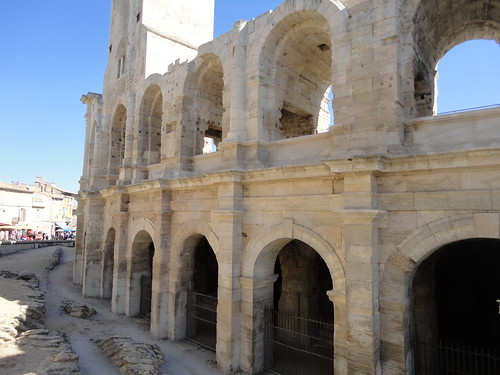 |
| Arles' Roman amphitheatre |
Having naturally acquired many Italian words to our limited repertoire whilst in Italy, we automatically responded with ‘si’ and ‘gratzie’ against this new backdrop, then quickly replaced them with “oui” and “merci”. So, it was no wonder that we were continually mistaken for tanned Italian tourists. However, unlike Italy where places are buzzing with people at night time, evenings on the old Roman streets of Arles were relatively quiet.
 |
| Arles street with amphitheatre in background |
Vincent Van Gogh is a big name here in Arles, where he spent time living with Paul Gaugin and painting before committing himself to an asylum. The central Place du Forum, which houses the café that Van Gogh famously painted in ‘Starry Night’, has the tourists flocking to its many eateries including these two little black ducks for very average, moderately priced meals with a roving Spanish guitarist thrown in for ambience. But we weren’t here for the art or the artists this time, our second visit after 17 years. What attracted us were the Camargue area to the south of Arles and the Provencal scenery to the north.
The Camarguaise area, flat and filled with swamps and salty marshes along the coast, is home to a wide range of birdlife including flocks of pink flamingos that we observed picking for food through wetlands at the large regional nature park. Beware the mosquitoes! We passed black bull farms and stables of white Camargue horses. This is cowboy country with a Spanish-French twist. There are white-washed, blue-shuttered houses some with horned bull skulls proudly on show on walls and some with thatched roofs. In the nearby coastal town of Saintes-Maries De La Mer, cowboy boots are for sale, along with horse saddles and belt buckles that would appeal to the Marlborough man within you. Shops display names such as El Rio Grande and Sitting Bull, and stuffed toy bulls are popular souvenirs. |
| Flamingos in the Camargue |
In Sts-Maries De La Mer we visited a large church dedicated to the two Maries (Marie-Salome and Marie-Jacobe) who apparently were shipwrecked here. The church and the surrounding area attract Roma gypsies (called gitans) whose patron saint is the black Sara, whose relics are here along with relics of the Maries. We found an underground church crypt that had a fascinating gypsy shrine devoted to Sara.
 |
| Siesta time. Side street, Saintes-Maries de la Mer |
Okay, so the French in these parts, unlike the rest of their countrymen, are into bull games. The Camarguaise bull games that we witnessed in Arles’ Roman amphitheatre involved young lads dressed in white (Max likened their outfits to cricket whites) running across the arena and taunting bulls to encourage them to take chase. The runner’s task is to run in front of the bull and snatch the ribbon tied between the bull’s brass-capped horns using a claw-like comb held in the hand. To escape a charging bull, runners leap high over the arena boundary with incredible energy and athleticism. The bulls don’t get hurt in the process but the team of 14 able-bodied men was reduced to 11 by the end of the show. Bulls win!
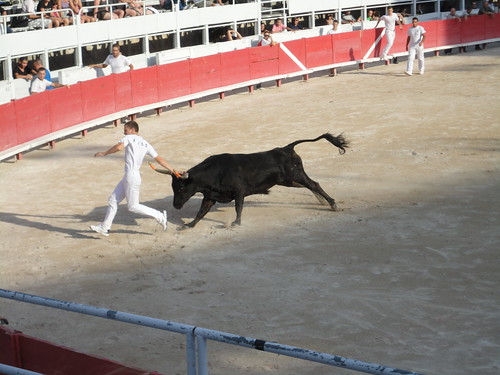 |
| Charge! |
 |
| Time out, guys! |
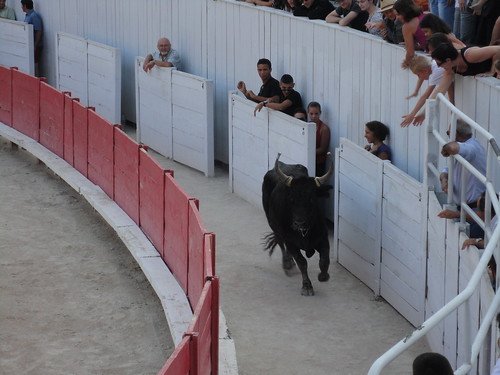 |
| Everyone takes cover as this smart bull jumps the barrier. |
We organised a stay at a French country-style house B&B a few kilometres out of Arles where we met up with two Italian families travelling together. This jovial, friendly bunch of four adults and four children invited us to join their family gatherings where we shared food, laughs and conversations. Carla and her husband work for the Senate in Rome and their English was very good which meant, having them as translators, we could all communicate.
To the north of Arles lies the Provencal region of Luberon. We managed to squish in a lot of places along a 100km route (plus return) into one scenic sunny daytrip that also included small hikes. Up in the pretty light coloured village of Gordes perched on its hilltop location, it was market day where trestles of local products, including colourful Provencal-designed linens, cheeses, sausages, nuts, olive oils, crafts and flowers, filled the small streets and town square. Bunches of deep purple highly-fragrant Provencal lavender were too irresistible to pass by. We bought a bunch to take with us along our trip.
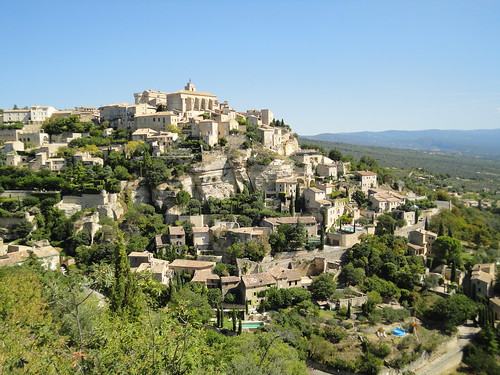 |
| Gordes |
Nearby is a tiny village of historic bories (huts made of stones) that have sat amongst hilltop farmlands for centuries. The dry stone huts reminded us of Irish ones we’d seen, such as the Gallarus Oratory on the Dingle Peninsula, only that these ones were set against a backdrop of a limestoney Mediterranean landscape with fig, olive and cypress trees. To reach the village meant driving very carefully along tight country laneways lined with high stone walls with an occasional little widening of the road to allow for passing traffic. As we were in a brand new lease car, Max was mindful of the paintwork and the side mirrors which on occasion had needed tucking in to get through tight spots, so we were hoping that we wouldn’t meet oncoming traffic. The bories were very impressive - stone housing, workshops and animal pens were grouped together like a small commune. Considering that no mortar was used to build the roofs and walls, they were an amazing feat of architectural engineering.
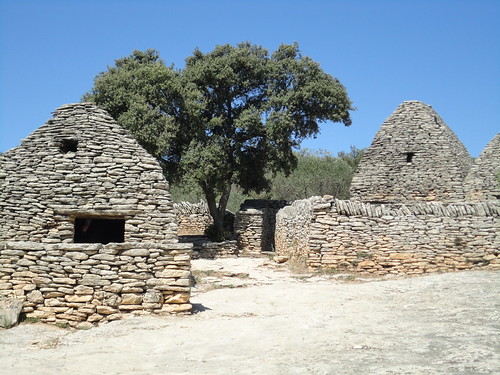 |
Village of bories |
The salmon pink-coloured clifftop town of Roussillon with its terracotta roofs lit up under a sunny sky was an absolute delight. Roussillon is renowned for its ochre canyons and quarries. We hiked through the Sentier des Ocres, the ochre trail that led downhill through a veritable colour chart of deep yellow and red ochres, apricots and melons interspersed with streaks of russets, maroons and burnt umber. Tall trees of chestnuts and cypresses shaded the canyon floor providing cool respite from the glare of the sun. By the time we’d finished hiking the ochre trail, our walking boots and socks were coated yellow by the fine pigments underfoot.
 |
| Hikers on the Ochre Trail |
Further past Roussillon is the Colorado du Provencal near a tiny village called Rustrel. This is a strange rock landscape that rises suddenly from surrounding forests and was once an ochre quarry. We followed the marked trails, hiking around and over ochre formations that looked like mini-me versions of Uluru (Ayers Rock) and others with names such as the Sahara. Driving through the Luberon’s fields and rolling hills, lavender bushes neatly trimmed of their summer flowers sat looking like silvery grey pincushions lined up in orderly rows.
 |
| Cafe life, Roussillon |
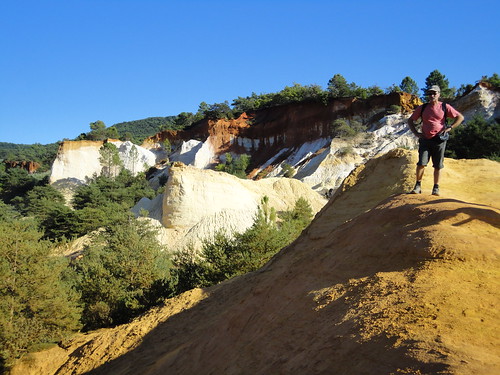 |
| Surveying the lay of the land, Colorado du Provencal |
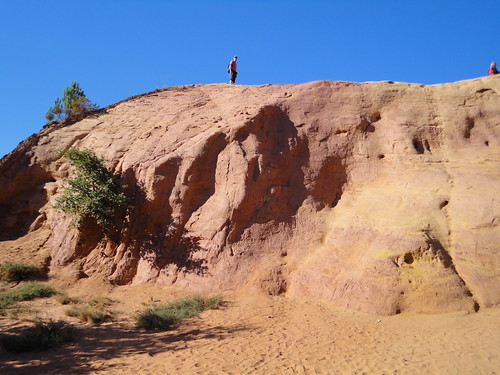 |
| Max on top, Colorado du Provencal |
The Camargue and Luberon areas of Provence are so vastly different from each other in terrain, sights and customs, and yet surprisingly a short distance from each other within the same country. Black bulls, white horses and pink flamingos around wetland coastal plains and then the inland colours of limestone, ochres and terracottas amid green pastoral scenes at the other. What a colourful, intriguing glimpse of contrasts it has been for us.


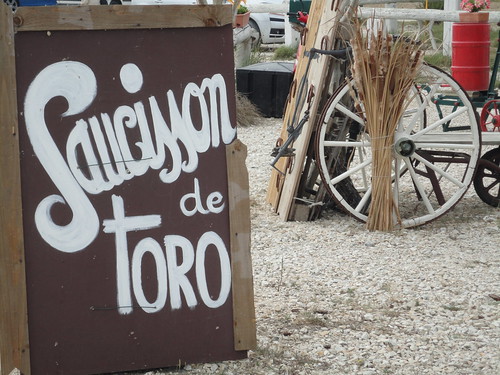
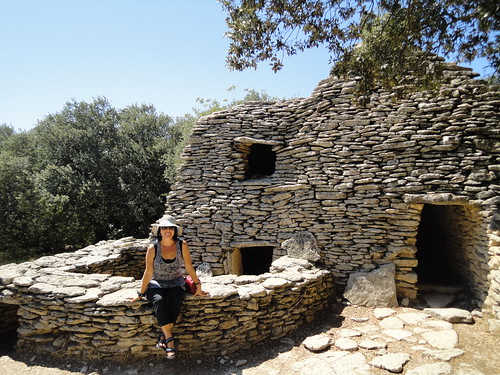
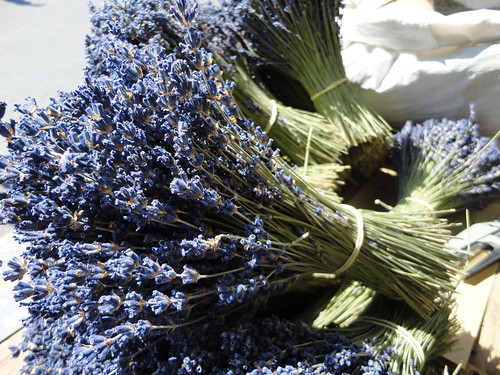
 Hi, I'm Eva - world traveller, cultural explorer and experience seeker. Together with my husband Max, we've been globetrotting for over 20 years.
Hi, I'm Eva - world traveller, cultural explorer and experience seeker. Together with my husband Max, we've been globetrotting for over 20 years.







0 comments: